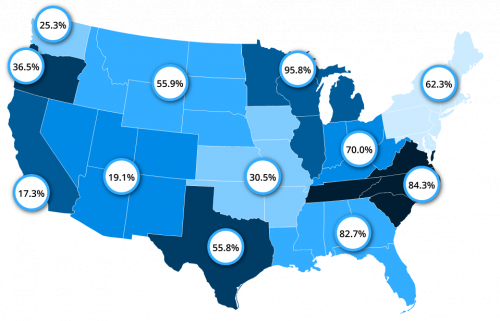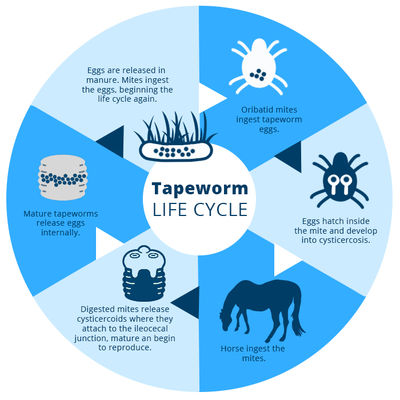Recent research revealed that more than 50% of horses tested in the United States have been infected with tapeworms.
Thanks to increased awareness and the availability of EQUIMAX® to treat tapeworms, you can take steps to reduce your horse´s risk of illness associated with this prevalent parasite.
Ileal Impaction Colic
- Occurs when an obstruction prevents the passing of digested material.
- Research indicates that more than 80% of these colics are associated with tapeworms.2
EQUIMAX® controls tapeworms (A. perfoliata) that may cause certain types of colic.
Inside the Tapeworm
Tapeworm Species
- Anoplocephala perfoliata
- Anoplocephala magna
- Paranoplocephala mamillana
Three species of equine tapeworm affect the horse. Anoplocephala perfoliata is by far the most prevalent and is of the most concern to horse owners. Anoplocephala magna and Paranoplocephala mamillana, however, do occur elsewhere in the world but are rare in the United States.
Tapeworm Characteristics
The tapeworm belongs to a class of parasites known as cestodes - unlike roundworms and strongyles, which are nematodes. Tapeworms have a simple body structure, composed of a scolex, which attaches to the intestinal wall of the horse, and many proglottids, or body segments, each of which contains reproductive organs and eggs. The tapeworm receives nutrients through its tegument - its absorptive outer layer.
Anoplocephala perfoliata
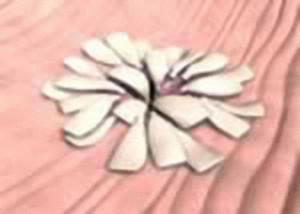
Anoplocephala perfoliata is the most abundant and infective of the equine tapeworms. It usually measures about 1 to 3 inches in length and has a rounded scolex with four hooks that allow it to attach to the horse’s intestin.
Tapeworm Eggs
The very nature of tapeworm eggs makes diagnosis of their presence extremely difficult. Tapeworm eggs occur in very small numbers, and many times they exist in packets rather than as individual eggs. The excreted tapeworm eggs don't float well in traditional fecal floatation tests, which means they evade veterinary detection quite easily.
The Ileocecal Junction
Anoplocephala perfoliata tend to congregate on the surface of a unique area in the horse - the ileocecal junction. This spot is the common opening between the ileum, or small intestine, the colon and the cecum, the pouch that is the beginning of the large intestine and serves as a kind of fermentation vat.
To get a better understanding of the tapeworm's life cycle and how it affects the horse, let's take a look at the anatomy of a normal horse Anatomy of a normal horse.
An Indirect Life Cycle
All tapeworms have an indirect life cycle; they need an intermediate host in order to complete their life cycle. Equine tapeworms use an extremely common, tiny, pasture-dwelling insect for this purpose - the oribatid mite. These mites are very small, and they're found in virtually all soils all over the world.
Lifecycle of the Tapeworm
- Oribatid mites are invisible to the eye and can be found on many sources such as hay, feedstuffs, straw and pastures.
- Tapeworm-infected horses may appear in good health and do not exhibit visible signs of damage, such as dull hair coat and diarrhea.
- Because tapeworm eggs are contained in packets and do not float well, fecal egg tests are only 3.1% accurate, making it extremely difficult to diagnose tapeworms in affected horses.3
- Left untreated, tapeworms can cause serious health problems and result in death.
Tapeworm Damage
Tapeworm Colonization
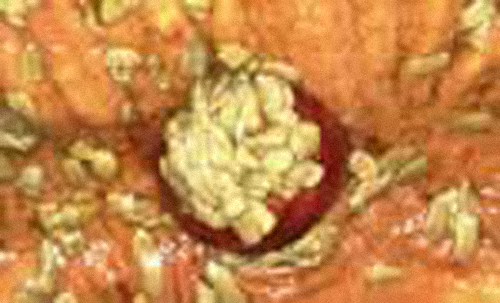
So why is it important that so many horses are exposed to tapeworms? What kind of damage do tapeworms cause that makes them such a threat? The damage begins because of the way that Anoplocephala perfoliata colonize around the ileocecal junction. As this image shows, the large numbers of parasites concentrated in a single area, and the fact that they attach to the mucosa with strong hooks, create a tremendous amount of irritation and inflammation at this important junction of the small intestine, cecum and colon. Let's watch as this occurs Tapeworm Inflammation.
Tapeworm Attachment
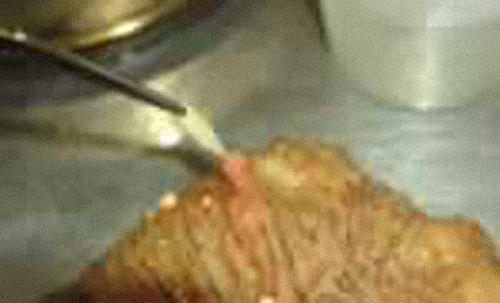
Tapeworms attach tightly to the gut wall. This picture illustrates that attachment and shows the ulcerations it can leave behind.
Damage to the Gut Wall
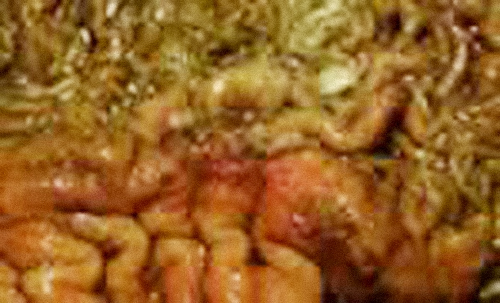
Tapeworms can spread out over a fairly large area around the ileocecal junction if the infection is severe enough. Their presence causes irritation wherever they go. This section of gut wall has had a number of tapeworms removed from it, revealing the damage their presence creates.
Ileocecal Intussusception
The tapeworm has been indicated in three specific types of colic in horses. The first is intussusception. Remember that ingested material is moved through the digestive tract with the help of waves or peristalsis. When tapeworms are present, the inflammation they cause can exaggerate these waves at the ileocecal junction, and the small intestine may actually push its way into the cecum as a result. This type of colic is very serious, and virtually all intussusception colics are caused by tapeworm infections. Let's take a closer look Ileocecal Intussusception.
Impaction Colic
The disruption of normal peristalsis through the ileocecal junction can cause impaction colic. In ileocecal impaction colic, fecal matter in the cecum isn't expelled and backs up into the small intestine. This is a long-term, slow colic, as additional digested materials continue to pile up. Here's how it works Impaction Colic.
Spasmodic Colic
Spasmodic or gas colic is extremely common in horses and often associated with tapeworms. It is caused by gas trapped as a result of abnormal peristalsis. The peristaltic waves become erratic, and the intestine seems almost to spasm. This is what it looks like Spasmodic Colic.
Tapeworm Damage Summary
Tapeworms are a threat to the health of horses in the United States and around the world. This pest causes severe inflammation at the ileocecal junction and affects normal peristalsis of the gut, impairing a horse's condition and performance, while causing multiple types of potentially life-threatening colics.
The correlation between tapeworm presence and the occurrence of colic is strong. Tapeworms are the primary cause of all ileoccecal intussusceptions. Tapeworms cause approximately 81 percent of ileocecal impaction colics and 22 percent of spasmodic colics.
Now that we know the incidence of tapeworm exposure and the significant damage these parasites cause, what can owners do to protect their horses from this threat?
1. C.R. Reinemeyer, A.W. Farley, S.A. Kania, B.W. Rohrbach and R.H. Dressler, 48th Annual Meeting of the American Association of Veterinary Parasitologists, Denver, CO, July 2003.
2. C.J. Proudman, N.P. French and A.J. Trees, Equine Veterinary Journal 1998; 30 (3): 194–199.
3. E.T. Lyons, S.C. Tolliver, J.H. Drudge et al. Parasites in Kentucky Thoroughbreds at necropsy: Emphasis on stomach worms and tapeworms. American Journal of Veterinary Research 1993; 44: 839–844.
4. Mercier P., Bousquet E., Sanquer A, et al. Time of re–appearance of fecal tapeworm eggs in horses treated with an ivermectin–praziquantel combination and left in their contaminated environment. World Association Adv. Vet Parasitol 21st International Conference. 19–23 August, 2007, Ghent, Belgium.

